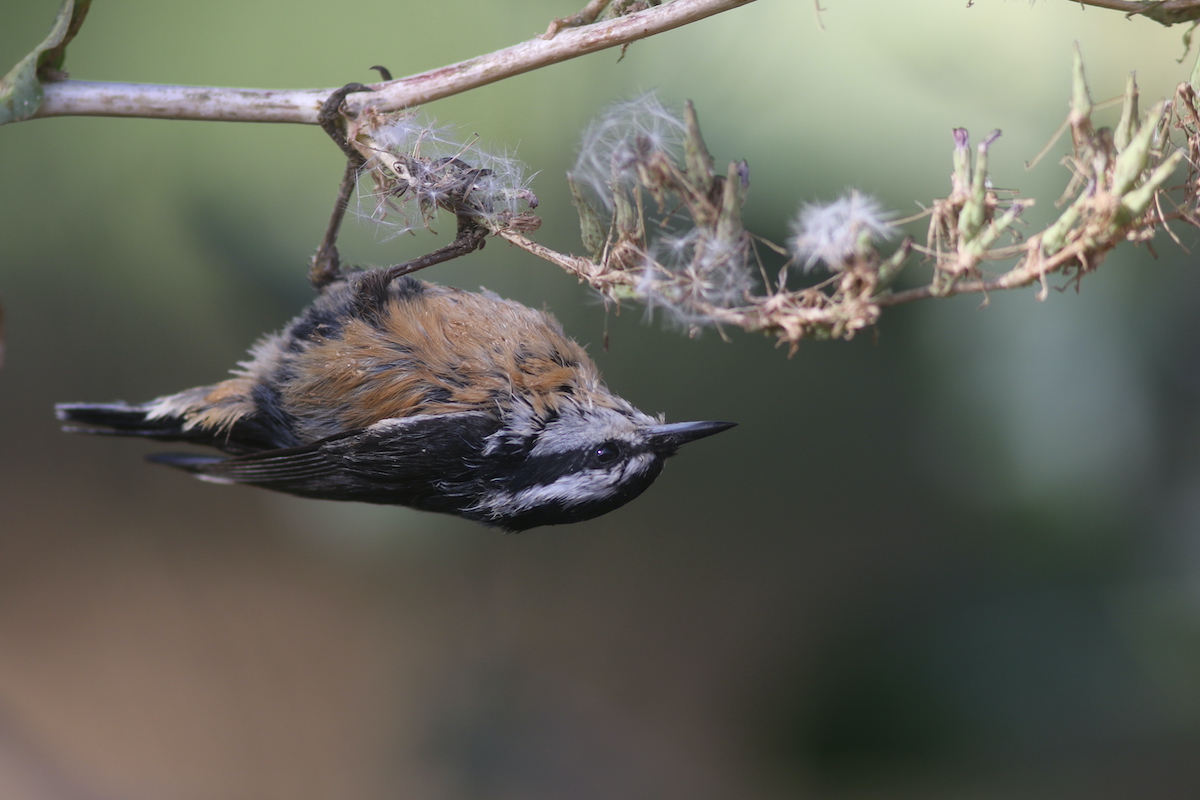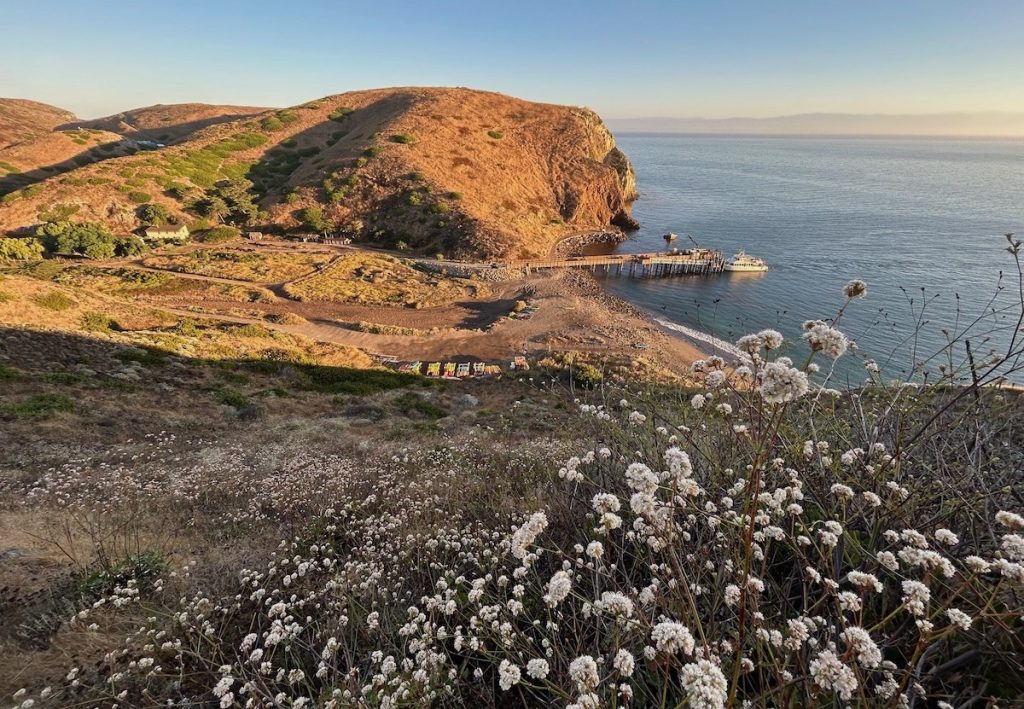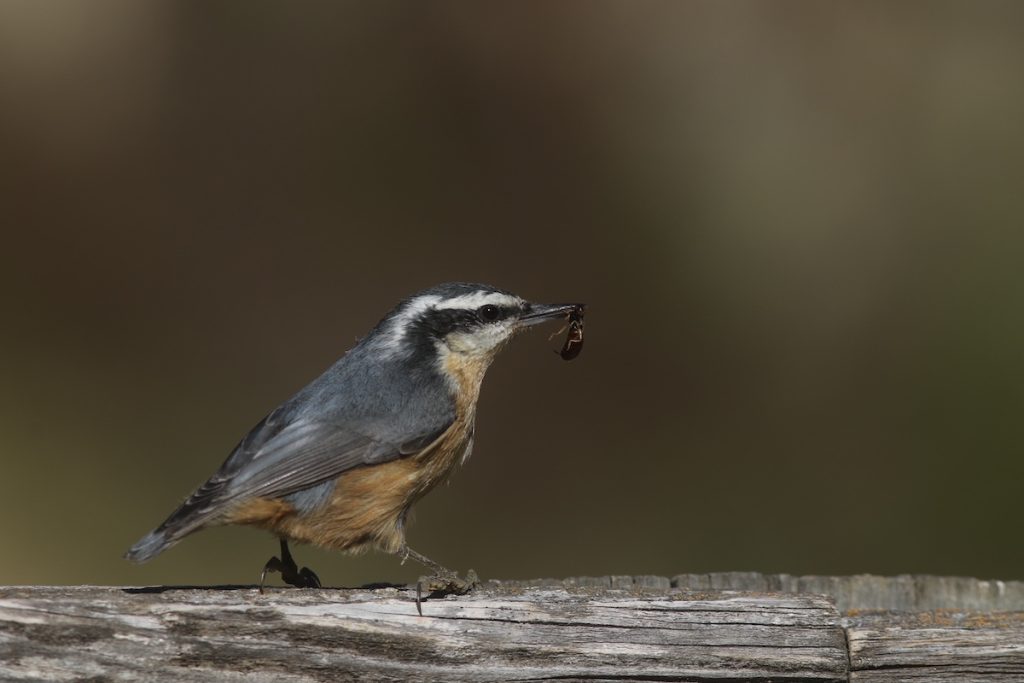Nuthatch Nirvana

During the fall, when it’s hot and dry on the southeast end of Santa Cruz Island, cold, crisp, purple grapes are a must-have fruit on the largest isle off the California coast.
It’s also a time for annoying, seemingly perpetual deer flies that seek moisture out of the ears, nose, and eyes. To momentarily escape those bothersome insects, I seek refuge in the guide shed. The shed is there for as many as 15 guides at a time sharing a 7’x7’ space, storing a yard sale of packs, kayaking gear, handheld radios, sea cave lights, coolers, and who knows what else. When I duck inside to escape from the flies, I keep the door open, but for whatever reason the deer flies don’t venture inside too often.
This past fall, during a rare, cool September morning, I was enjoying one of those recent moments of calm away from the whining flies along with a sweet strand of cool, crunchy grapes. Suddenly, a surprise visitor arrived that I hadn’t seen in the rugged canyon for nearly five years. A tiny, adorable, red-breasted nuthatch flew inside the shed and landed on my weathered index finger. While I chomped on my grapes, the encounter was very brief, but for the next six weeks roughly 12 of those little cuties hung out between the lower campground and the old ranch house in lower Scorpion Canyon. I was in nuthatch nirvana.
The influx of nuthatches was due to low seed banks from conifer trees in Northern California, forcing batches of hungry nuthatches to migrate south for alternative food sources. Nuthatches are the only non-woodpecker that makes cavities to store food. The only other occasion I had seeing a red-breasted nuthatch on the island was on the massive trunk of a lone Monterey cypress just east of the lower campground. Perpetual motion kept that singular bird investigating every crevice of loose bark as it easily crept up and down the burly tree like a feathered version of Spider-Man.
Dirty Days

Coming and going from the islands, things change quickly out there from one three-to-five-day run to the next. Kayak guides cross paths with everyone’s schedules overlapping, so there’s always updated reports on the latest and greatest wildlife sightings.
Fall is definitely one of those active times of the year because of migrating birds. It seems like every fall and spring there’s an amazing sighting of a bird we’ve never seen on the islands, or we only see it on the mainland. That’s why the islands are such an important pit stop for birds getting blown off course during migration, a pelagic refuge in open water.
Over the years, some of my favorite sightings at Scorpion Anchorage and Scorpion Canyon include the Pacific loon, red-naped sapsucker, mountain bluebirds, sage thrasher, ovenbird, bobolink, merlin, American redstart, black-headed grosbeak, black-throated blue warbler, summer tanager, and painted bunting. The most recent influx of red-breasted nuthatches, though, was really entertaining, and they lived up to their avian moniker, “the Upside-down Bird.”
Yank-yank

It’s kind of a nasally, high-pitched yank-yank. That’s how the Cornell Lab of Ornithology describes the calls of the frenetic, red-breasted nuthatch. I was hearing them before seeing them on the island. However, they move quickly, and maneuver in ways that other birds do not.
This past fall, I saw a pair of nuthatches by the blue water spigot in the lower campground. They bathed in a muddy puddle despite yellowjackets buzzing around them. Their bathing was furious, and before I knew it, they hid themselves, air-drying in the eucalyptus trees hovering over the campground.
During those six weeks, the lower region of Scorpion Canyon was abuzz with the birdsong of hungry nuthatches. One of their favorite places to hang out was inside the fencing of the Gherini family’s historic Scorpion Ranch House. Inside the fencing were tall, spindly stands of prickly lettuce. In the mornings heavy dew clung to the pokey leaflets of the non-native flora. The little nuthatches would be soaked with moisture while traveling up and down swaying stocks of lettuce. Just a mere finger-length away from me, they become so satiated that they appeared catatonic while perched on the adjacent fencing. A few even dozed off as if in a trance before resuming their quest for food.
Seasonal Shift
Eventually though, their birdsong dissipated. With the arrival of daylight savings time, darkness falls quickly over Scorpion Canyon.
Powerful northeasterly winds also play a hand in birds moving on, as big wind events can trigger migrating birds to continue on their seasonal sojourns. By early November their birdsong faded, and they were gone.
It’s always a little somber in Scorpion Canyon when birdsong grows quiet and migrating birds move on. However, as the months pass, fall will loom on the horizon once again, as anticipation mounts. Who knows what might arrive? It’s high alert for birdsong and flashes of feathers on a chain of islands that provide a reliable haven for tuckered out migrators.






